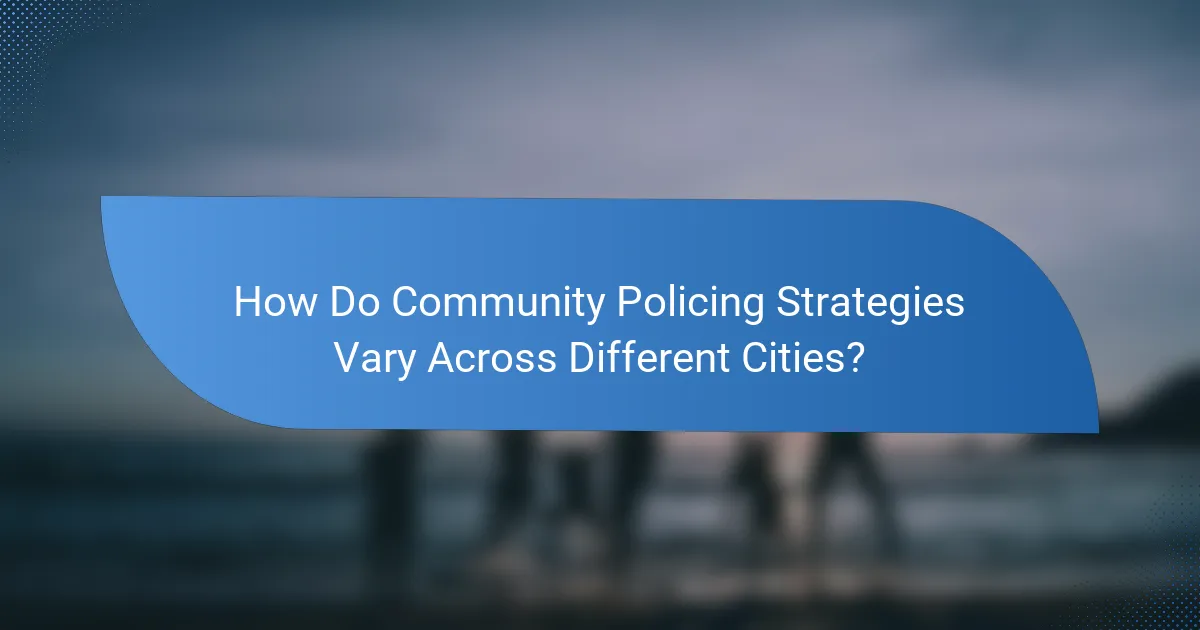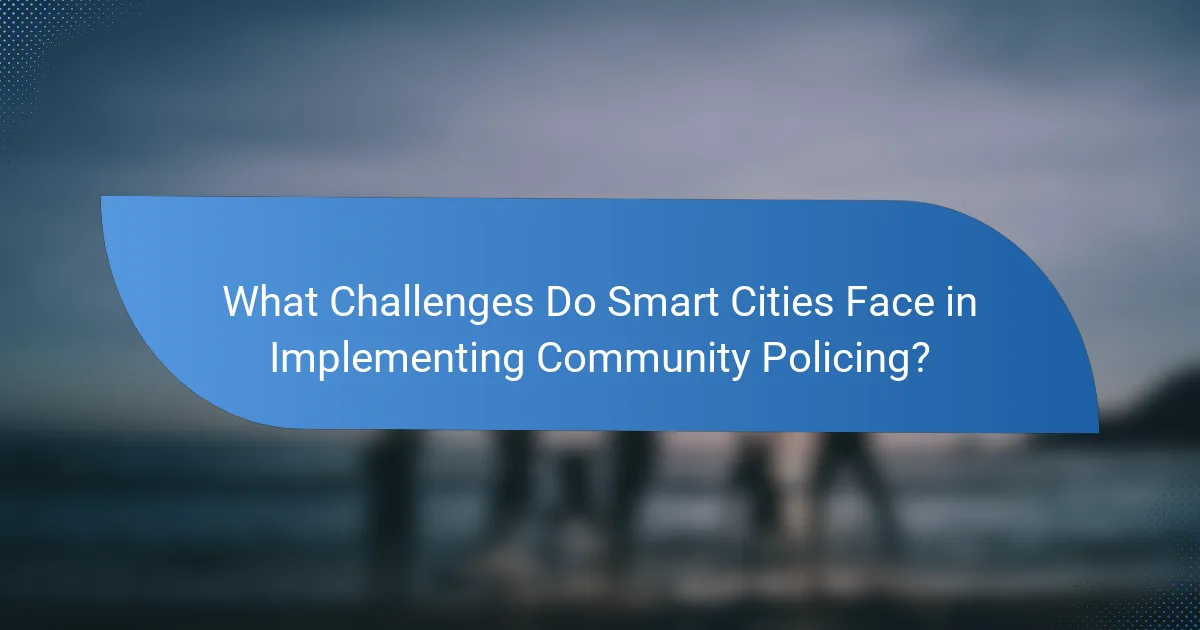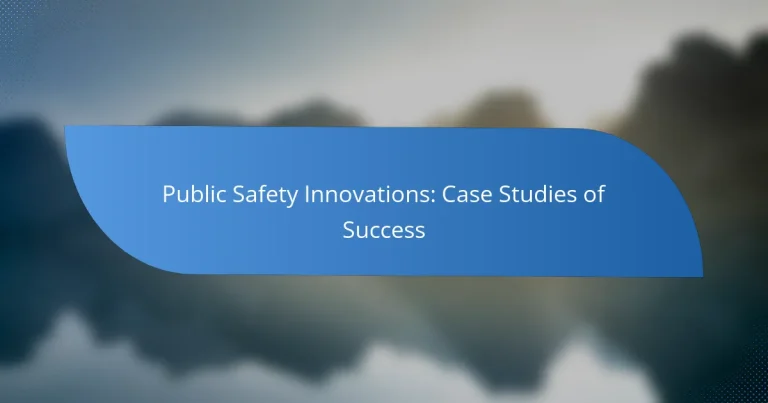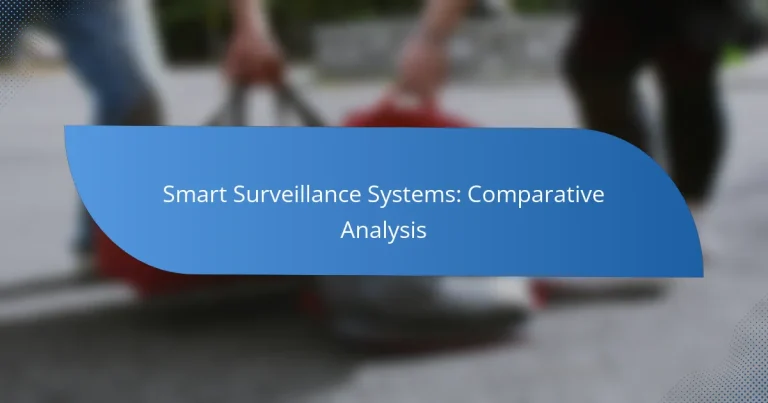Community Policing: Role in Smart City Initiatives
Community policing plays a vital role in smart city initiatives by strengthening the bond between law enforcement and residents, ultimately leading to safer, more engaged communities. By leveraging technology and data, this approach not only addresses public safety concerns but also fosters transparency and trust within neighborhoods, enhancing overall community well-being.

How Does Community Policing Enhance Smart City Initiatives?
Community policing enhances smart city initiatives by fostering collaboration between law enforcement and local residents, leading to safer and more engaged communities. This approach utilizes technology and data to address public safety concerns while promoting transparency and trust within neighborhoods.
Improved public safety
Community policing contributes to improved public safety by building relationships between officers and community members. When residents feel comfortable reporting issues, law enforcement can respond more effectively to crime and safety concerns.
For example, neighborhood watch programs can be supported by police, creating a proactive approach to crime prevention. This collaboration often results in lower crime rates and a greater sense of security among residents.
Increased community engagement
Increased community engagement is a key benefit of community policing, as it encourages residents to participate in local governance and safety initiatives. Regular community meetings and outreach programs allow citizens to voice their concerns and collaborate on solutions.
Engagement can take various forms, such as public forums, social media interactions, or community events, fostering a sense of ownership and responsibility among residents for their neighborhoods.
Data-driven decision making
Data-driven decision making is central to the effectiveness of community policing in smart cities. By analyzing crime data and community feedback, law enforcement can identify trends and allocate resources more efficiently.
For instance, using geographic information systems (GIS) can help police departments visualize crime hotspots and deploy officers strategically, enhancing their response capabilities and improving overall safety.
Collaboration with local organizations
Collaboration with local organizations is essential for successful community policing. Partnerships with schools, businesses, and non-profits can lead to comprehensive strategies that address underlying social issues contributing to crime.
Such collaborations might include youth programs, mental health services, or job training initiatives, creating a holistic approach to community well-being and crime reduction.
Resource allocation efficiency
Resource allocation efficiency is improved through community policing by ensuring that law enforcement efforts align with the specific needs of the community. By engaging with residents, police can better understand where to focus their resources.
For example, if a neighborhood reports a rise in drug-related incidents, police can allocate more patrols or invest in community outreach programs to address the issue directly, optimizing their impact on public safety.

What Are the Key Components of Community Policing in Smart Cities?
Community policing in smart cities focuses on building relationships between law enforcement and the community, utilizing technology to enhance safety and engagement. Key components include community partnerships, problem-solving strategies, and decentralized policing, all aimed at fostering trust and collaboration.
Community partnerships
Community partnerships are essential for effective community policing in smart cities. These collaborations involve local organizations, businesses, and residents working together with law enforcement to identify and address public safety concerns. For example, neighborhood watch programs or community advisory boards can facilitate communication and feedback between police and citizens.
To establish strong partnerships, police departments should actively engage with community members through regular meetings, events, and outreach initiatives. This engagement helps build trust and encourages community members to participate in safety initiatives, ultimately leading to a safer environment.
Problem-solving strategies
Problem-solving strategies in community policing focus on identifying specific issues within a community and collaboratively developing solutions. This approach often involves gathering data, analyzing crime patterns, and engaging residents to understand their concerns. For instance, if a neighborhood experiences a rise in vandalism, police can work with residents to implement surveillance measures or community clean-up events.
Effective problem-solving requires a proactive mindset, where law enforcement anticipates potential issues and addresses them before they escalate. Training officers in conflict resolution and community engagement techniques can enhance their ability to implement these strategies successfully.
Decentralized policing
Decentralized policing refers to distributing law enforcement resources and decision-making closer to the community level. This model allows local officers to respond more effectively to the unique needs of their neighborhoods. By empowering officers to make decisions based on local knowledge, communities can experience quicker and more relevant responses to incidents.
Implementing decentralized policing may involve creating smaller precincts or community policing teams that focus on specific areas. This structure encourages officers to build relationships with residents and fosters a sense of accountability, as officers become more familiar with the community they serve.

What Technologies Support Community Policing in Smart Cities?
Community policing in smart cities is enhanced by various technologies that facilitate communication, data collection, and real-time response. Key technologies include surveillance systems, mobile applications, data analytics platforms, and social media engagement tools, all of which work together to improve public safety and community relations.
Surveillance systems
Surveillance systems play a crucial role in community policing by providing real-time monitoring of public spaces. These systems often include high-definition cameras equipped with facial recognition and motion detection capabilities, allowing law enforcement to respond swiftly to incidents.
When implementing surveillance systems, cities should consider privacy regulations and community acceptance. Transparent policies and community input can help mitigate concerns about surveillance overreach.
Mobile applications
Mobile applications are essential for fostering communication between law enforcement and the community. These apps can allow residents to report crimes, share tips, and receive alerts about local incidents or safety concerns.
Effective mobile applications should be user-friendly and accessible to all community members. Features like real-time notifications and location-based services can significantly enhance community engagement and responsiveness.
Data analytics platforms
Data analytics platforms enable law enforcement agencies to analyze crime patterns and trends, leading to more informed decision-making. By utilizing historical data, these platforms can help identify hotspots and allocate resources more effectively.
Agencies should ensure that data used in analytics is accurate and up-to-date. Regular training on data interpretation and ethical considerations can help officers make the most of these tools while respecting community privacy.
Social media engagement tools
Social media engagement tools are vital for building relationships between police and the community. These platforms allow law enforcement to share information, promote safety initiatives, and respond to community concerns in real-time.
To maximize effectiveness, police departments should actively monitor social media channels and engage with community members. Establishing a consistent presence and responding promptly can foster trust and cooperation between law enforcement and the public.

How Do Community Policing Strategies Vary Across Different Cities?
Community policing strategies differ significantly across cities, influenced by local demographics, crime rates, and community engagement levels. Each city tailors its approach to address specific challenges and leverage unique opportunities for collaboration between law enforcement and residents.
Case study: New York City
In New York City, community policing emphasizes building trust through neighborhood policing teams that focus on specific precincts. Officers engage with residents at community meetings and events, fostering open communication about safety concerns and local issues.
The NYPD has implemented initiatives like the “Neighborhood Policing” program, which assigns officers to specific areas for better relationship-building. This strategy has led to a reported decrease in crime rates in neighborhoods with active community engagement.
Case study: Los Angeles
Los Angeles employs a community policing model that integrates social services with law enforcement efforts. The LAPD collaborates with local organizations to address underlying issues such as homelessness and mental health, which can contribute to crime.
Programs like the “Community Safety Partnership” focus on proactive measures, allowing officers to work alongside community members to identify and resolve problems. This approach has shown promise in reducing gang violence and improving community relations.
Case study: Chicago
Chicago’s community policing strategy is characterized by its emphasis on neighborhood safety and crime prevention through community engagement. The Chicago Police Department encourages residents to participate in local policing councils, fostering a sense of ownership over public safety.
Efforts such as the “Chicago Alternative Policing Strategy” (CAPS) have aimed to build partnerships between police and community members. This initiative has faced challenges, including resource allocation and community trust, but remains a critical component of the city’s approach to policing.

What Challenges Do Smart Cities Face in Implementing Community Policing?
Smart cities encounter several challenges when integrating community policing, including resource limitations, trust issues within the community, and hurdles in technology integration. Addressing these challenges is crucial for fostering effective collaboration between law enforcement and residents.
Resource limitations
Many smart cities operate under tight budgets, which can restrict funding for community policing initiatives. Limited financial resources may hinder the ability to hire additional officers, provide training, or invest in community outreach programs.
To mitigate these limitations, cities can explore partnerships with local organizations or seek grants specifically aimed at enhancing community policing efforts. Prioritizing initiatives that offer the highest return on investment can also help allocate resources more effectively.
Community trust issues
Building trust between law enforcement and community members is essential for successful community policing, yet many smart cities face skepticism from residents. Historical tensions, perceived biases, or negative past experiences can lead to reluctance in engaging with police initiatives.
To improve trust, police departments should focus on transparency and consistent communication. Hosting community forums, engaging in active listening, and demonstrating accountability can foster a more positive relationship with residents.
Technology integration hurdles
Integrating advanced technologies into community policing strategies can be challenging due to compatibility issues, data privacy concerns, and the need for training. Smart cities must ensure that new technologies align with existing systems and that officers are adequately trained to use them.
Establishing clear protocols for data usage and privacy can alleviate community concerns. Additionally, involving community members in discussions about technology implementation can enhance acceptance and cooperation.




